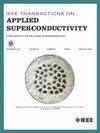不同电压引线双层屏蔽YBCO电缆交流损耗的测量
IF 1.8
3区 物理与天体物理
Q3 ENGINEERING, ELECTRICAL & ELECTRONIC
引用次数: 0
摘要
本文采用六种不同电压引线对双层屏蔽YBCO电缆模型进行了测量和分析。在不同层电流分布下,分别研究了vo -引线、s -引线和co -引线测量的损耗特性,并论证了不同电压引线测量的损耗之间的关系。实验结果表明,在YBCO电缆模型中,s -引线测量的损耗与vo -引线测量的损耗相比非常小,特别是在go-return模式下。外屏蔽体的损耗随磁场大小和方向的变化而变化,而内导体的损耗基本不受屏蔽体磁场的影响。在当前两种运输方式下,co -铅的损失是s -铅和vo -铅的加或减。随进模式下的损耗明显大于随回模式下的损耗,这是由于导体和屏蔽产生的磁场方向不同造成的。此外,通过与BSCCO电缆模型的对比分析,更充分地说明了双层线屏蔽YBCO电缆模型的交流损耗特性。YBCO线在降低高温超导电缆的交流损耗方面具有明显的优势。本文章由计算机程序翻译,如有差异,请以英文原文为准。
Measurement of AC Loss of Double-Layer Shielded YBCO Cable Model With Different Voltage Leads
In this article, a model of double-layer shielded YBCO cable is measured and analyzed by six different voltage leads. Under the current distribution of different layers, the loss characteristics measured by VO-lead, S-lead, and CO-lead are studied, respectively, and the relationship between the losses measured by different voltage leads is demonstrated. The experimental results show that the loss measured by S-lead is very small compared with the loss measured by VO-lead in the YBCO cable model, especially in go–return mode. The loss of the outer shield varies with the change of the magnetic field’s magnitude and direction, while the loss of the inner conductor is basically not affected by the magnetic field of the shield. Under the two current transportation modes, the loss of the CO-lead is the addition or subtraction of the S-lead and VO-lead. The loss in go–go mode is obviously bigger than that in go–return mode, which is due to the different direction of magnetic field produced by the conductor and shield. In addition, the comparative analysis with the BSCCO cable model more fully illustrates the ac loss characteristics of the double-layer wire shielded YBCO cable model. The YBCO wire has obvious advantages in reducing the ac loss of high-temperature superconducting cables.
求助全文
通过发布文献求助,成功后即可免费获取论文全文。
去求助
来源期刊

IEEE Transactions on Applied Superconductivity
工程技术-工程:电子与电气
CiteScore
3.50
自引率
33.30%
发文量
650
审稿时长
2.3 months
期刊介绍:
IEEE Transactions on Applied Superconductivity (TAS) contains articles on the applications of superconductivity and other relevant technology. Electronic applications include analog and digital circuits employing thin films and active devices such as Josephson junctions. Large scale applications include magnets for power applications such as motors and generators, for magnetic resonance, for accelerators, and cable applications such as power transmission.
 求助内容:
求助内容: 应助结果提醒方式:
应助结果提醒方式:


